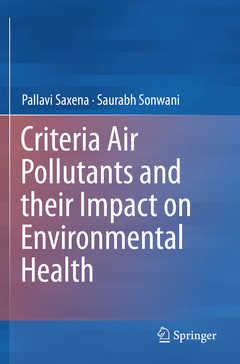Description
Criteria Air Pollutants and their Impact on Environmental Health, 1st ed. 2019
Authors: Saxena Pallavi, Sonwani Saurabh
Language: English
Subjects for Criteria Air Pollutants and their Impact on...:
105.49 €
In Print (Delivery period: 15 days).
Add to cartPublication date: 11-2020
157 p. · 15.5x23.5 cm · Paperback
105.49 €
In Print (Delivery period: 15 days).
Add to cartPublication date: 11-2019
157 p. · 15.5x23.5 cm · Hardback
Description
/li>Contents
/li>Biography
/li>Comment
/li>
Air pollution is a global hazard. Majority of the world?s population is affected by air pollution. Contamination of air is no more an only an atmospheric problem but now has become a health concern too. Under the Clean Air Act of 1971, a set of air pollutants are designated as criteria pollutants. These are suspected to be strongly harming the public health and the environment as compared to other primary and secondary pollutants.
Globally, this category of air pollutants has been given less attention, only few studies have been reported in this area. This book begins with a short background on criteria air pollutants and their sources, sinks and chemistry. The chapters explore the detailed nature of primary pollutants criteria pollutants such as nitrogen dioxide, sulphur dioxide, carbon monoxide, particulate matter and lead. Their reaction mechanisms, climate change potency, environmental health effects on plants and human life are discussed. The book also covers secondary pollutants such as ozone. The book discusses ozone chemistry and its environmental health effects. This book act as a valuable tool for students in Environmental Science, Biological Science and Agriculture, as well as environmental consultants and professionals involved in air quality research and the application of air quality guidelines and advice.
Tentative Table of Contents—
1. Introduction .- 2. Criteria Air Pollutants: chemistry, sources and sinks.- 3. Primary Criteria Air Pollutants: Environmental Health Effects .- 4. Secondary Criteria Air Pollutants: Environmental Health Effects .- 5. Policy Regulations and future recommendations.
Dr. Pallavi Saxena is an Assistant Professor, Environmental Science, Hindu College, University of Delhi, India. She has been awarded DST Fast Track Young Scientist Award at School of Environmental Sciences Jawaharlal Nehru University, New Delhi, India. She has done her Post Doc from Space and Atmospheric Sciences Division, Physical Research Laboratory (PRL), Ahmedabad, Gujarat, India. She has been elected as Chair of South Asia and Middleeast Region of Early Career Scientist Network of iLEAPS community, UK. She is also a co-author and collaborator from India of TOAR International Meeting which focuses on tropospheric ozone and its impact on vegetation. In addition to that, she has been a recipient of various awards like Young Scientist Award from Indian Society of Plant Physiology, DBT BioCaRe Award. Several travel grant awards from WMO, IGAC and NOAA to participate as an expert in Ozone Pollution and Its Impact on Vegetation in TOAR Meeting.
Dr.Saurabh Sonwani recently awarded his Doctoral degree from School of Environmental Sciences (SES), Jawaharlal Nehru University (JNU), New Delhi, India. He has also completed his M.Phil. degree from SES, JNU, New Delhi. He completed his Master in Science (Environmental Sciences) from Banaras Hindu University (BHU), Varanasi, India. His area of expertise includes atmospheric chemistry, climate change and environmental health. Dr. Sonwani is an advisory board member at Cambridge Scholars Publishing House, England, the UK in the “Environmental Sciences” section. He is also an active member of the iLEAPS scientific community from South Asian and Middle East Early Career Scientists Network (SAMEECSN). He has both research and teaching experiences in the field of Environmental Sciences. Dr. Sonwani is a recipient of JRF and SRF through the UGC after qualifying test conducted by Council of Scientific and Industrial Research and University Grant Commission jointly (CSIR-UGC) in the area of Ear
These books may interest you

Environmental Hygiene II 105.49 €



